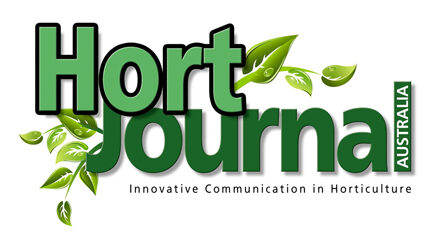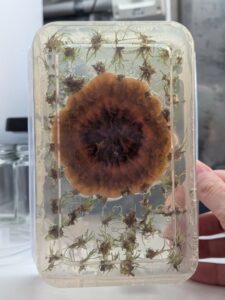
Challenging, persistent and a bit gross!
Contamination in plant tissue culture
By Lisa Wightwick
Wherever plant tissue culture goes, so follows contamination. But what is culture contamination, where does it come from and why is it so undesirable?
In the context of plant tissue culture, ‘contamination’ is a broad term that describes a range of unwanted microorganisms that can have significant impacts on the health and success of the plants. Fungi, bacteria, yeast, algae and insects are among the range of invaders that can be encountered throughout the tissue culture cycle. Fungi and bacteria are the most common contaminants, generally due to their high presence and transmissibility among plant and human life. Yeast, algae and miniscule pests such as mites and thrips can be more problematic to cultures than fungi and bacteria, but thankfully, are much less common. So how and why do these microorganisms pose a threat in plant tissue culture and how do they infiltrate in the first place?
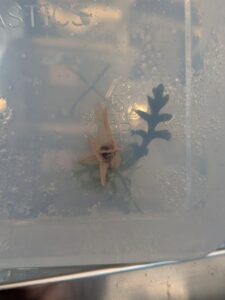
Plant tissue culture and its applications like micropropagation utilise a special type of media on which the plants are grown. The media is comprised of water, a binding agent such as agar, growth regulators, nutrients, vitamins and sugar. This mixture contains everything the plants need to survive, but unfortunately, plants, fungi, bacteria and yeast all share a similar palette. High concentrations of nutrients, vitamins and sugar in the media, in addition to the nice, warm, humid culture storage environments, provide ideal living conditions for these bothersome invaders. Many of these contaminants enter the tissue culture environment by hitchhiking on personnel, plant material and equipment. Most of the contamination occurs when bacterial and fungal spores are shed or spread by workers when handing the culture media and plants, or is harboured by plant material at the initiation stage.
The occurrence of contamination in the initiation phase is to be expected and quite common. Outside plants (and humans too) play host to extremely diverse microbiomes that inhabit their tissues. When material is harvested to initiate into culture, it is subjected to a process of rigorous sterilisation where the plant tissues are soaked in various concentrations of bleach, ethanol and other sterilants. This process never guarantees the tissues have been completely cleansed of their inhabitants, as it generally targets the surfaces and not the inner tissues where microorganisms can hide. Any pesky contaminants which survive sterilisation will feed on the tissue culture media once the host material has been placed on it and quickly proliferate.
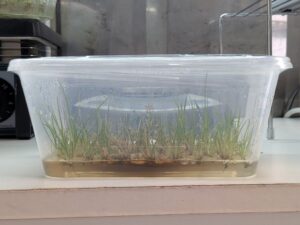
If a contaminant enters a tissue culture flask, it quickly establishes itself, overrunning the plants and media. This can occur in a matter of days or weeks, or sometimes contaminants can stay dormant within the plant tissues for longer periods and emerge later. While some species of fungi and bacteria may not be directly harmful to the plants, they can outcompete the plants for available resources in the media or produce byproducts that affect the plants and media. The culture plants may suffer from impaired growth, malnutrition, mutation, tissue necrosis and death. More sinister species of bacteria and fungi attack or feed on plant tissues. Severe incursions have the potential to wipe out large numbers of plants extremely quickly, voiding days, weeks, even years of research, labour and materials. Infestations of micro-pests, such as mites and thrips, although rare, are essentially a death sentence to the plant cultures. Due to their extremely small size, they are very difficult to detect and near impossible to eradicate once established. They also double the damage to plants by feeding on the plant tissues and spreading other microbial contaminants. Any infested cultures would need to be immediately quarantined and destroyed to prevent further spread.
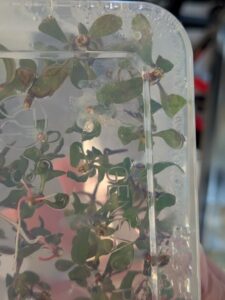
Tissue culture facilities must follow strict hygiene protocols and use specialised equipment to minimise the risk of contamination as much as possible. Prevention is one of the greatest tools in the fight against contamination, because once a culture becomes affected, it is very unlikely it can be treated or salvaged. Antibiotics and antifungal products can be incorporated in the media with varying success. Generally, these products are costly, can negatively impact the growth and vigour of tissue culture plants, and overuse can result in resistance.
Occasionally, contaminants and plants live in relative harmony in culture. Even with the most thorough decontamination and hygiene measures, some plant species are just too firmly colonised by endophytic bacteria and fungi, though they remain largely unaffected. If these plants are in high demand, rare or endangered, and grow better in tissue culture, the trade-off of benign systemic contamination is minimal and can be managed. Some plant cultures are purposely inoculated with beneficial fungi to improve growth and resilience. Mycorrhizal fungi are introduced to banana cultures at the acclimatisation stage to improve stress tolerance and hardening, and drastically improve germination, growth, and disease resistance of orchids through their symbiotic relationship.
Despite their challenging and sometimes repulsive nature, there is something to be said for the amazing diversity of textures, colours and forms of fungi, bacteria, yeast and algae. Some fungi look just like powdery white snow, turning a flask full of plants into a miniature winter landscape. Most others though, just elicit reactions of ‘eugh, yuck!’ or ‘what is that!?’ Whether interesting, nauseating or plant-destructing, microbial contaminants are synonymous with plant tissue culture and will remain ever-present hurdles to laboratories worldwide.
Lisa Wightwick
Peninsula Growers
